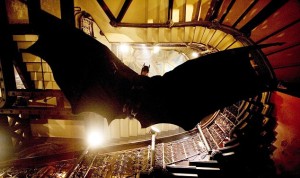 Over in the current issues of Marvel’s Captain America: Sam Wilson series, things have gotten rather…anamorphic. Thanks to a run in with Dr. Karl Malus, the current Captain America (Sam Wilson, the former Falcon) has been turned into a wolf-human hybrid, nicknamed Cap-Wolf. Also caught up in the mix was Sam’s pet falcon, Redwing, which got its genes mixed with a teenaged Mexican immigrant, Joaquin Torres.
Over in the current issues of Marvel’s Captain America: Sam Wilson series, things have gotten rather…anamorphic. Thanks to a run in with Dr. Karl Malus, the current Captain America (Sam Wilson, the former Falcon) has been turned into a wolf-human hybrid, nicknamed Cap-Wolf. Also caught up in the mix was Sam’s pet falcon, Redwing, which got its genes mixed with a teenaged Mexican immigrant, Joaquin Torres.
As a result of Torres’ and Redwing’s blending, Torres now has wings coming out of his arms…or his arms are now wings…or…something. Basically, he has wings (and scales, and falcon eyes – which will be cool to talk about later), and if the cover to issue #5 is to be believed; Torres is the new Falcon to Wilson’s Cap. This time though, the Falcon is more real “falcon” than Wilson was when he was the Falcon and Steve Rogers was Cap, which he will be again, shortly.
Comic book storylines, man.
What this all boils down to is that we’ve got (another) winged human flying around the Marvel Universe.
So let’s ditch Joaquin’s bird-man transformation and its visual metaphor for coolness, power and freedom, and dig into some science – the ages old question of why can’t we have wings?
Western culture likes to throw it back to Leonardo Da Vinci for the design, and the story of Icarus and his dad, Daedalus for the inspiration, but probably since our distant ancestors came down from the trees and saw birds flying, we’ve looked at our own arms, at a birds wing, and said, “Aw, nuts.”
People have tried and tried, but it doesn’t work.
It all comes down to bigness.
And physics.
And anatomy.
And power.
Let’s start with physics.
The physics concept of flight is very simple – in order to fly, you have to provide as much lift up as your weight pulls down. In a simple form, the formula shakes out like this:
Lift = ½ d v2A
L = lift
d = density of the air (easier to fly in less dense atmospheres then in more dense atmospheres)
v = velocity of the flying thing (plane, person, bird)
A = area of the wing.
(in something with fixed wings, the area of the wing is replaced with the coefficient of lift, determined by the airfoil (shape of the wing) and the angle of attack (at what angle the front of the wing meets the air))
Remember – all of this is just working to push air downward (and have the air push you upward in a nice Newton’s Third Law action-reaction pair). As a result, you’ve got some room for tradeoffs in there – if you want a small wing, you have to move it really, really fast – but that requires a lot of power – think of a hummingbird. You can move your wings slower, but then, they have to be bigger.
And your weight – don’t forget your weight. Small birds that barely weigh anything? Yeah – not a problem to get airborne. Humans?
This is where the anatomy comes in. If you, as a human being, want to fly under your own power, you’ve got to cut some serious weight. Birds do this by having bones that are less dense than ours – many are hollow with the most basic structural support inside. Less weight, easier to fly. If you’re a flying human – you may want to cut out some of those leg muscles, and make your legs really skinny. Really skinny. Not skipping leg day skinny, but bird skinny.
 But you still have to power those wings, right? And that power comes from muscles. Let’s say we ditch the idea of going by the codename “Hummingbird” and flapping our wings really, really fast (besides, no one is going to strike fear into the hearts of criminals with the name “Hummingbird”). We’re going to have big wings that we can flap relatively slowly to fly. By most estimates, a flying human’s wingspan that would provide enough area (if we could fly) would be at a minimum, 7 meters – about 23 feet.
But you still have to power those wings, right? And that power comes from muscles. Let’s say we ditch the idea of going by the codename “Hummingbird” and flapping our wings really, really fast (besides, no one is going to strike fear into the hearts of criminals with the name “Hummingbird”). We’re going to have big wings that we can flap relatively slowly to fly. By most estimates, a flying human’s wingspan that would provide enough area (if we could fly) would be at a minimum, 7 meters – about 23 feet.
You still need that power from your muscles. And arm and shoulder and back muscles, even if you’re in the gym every day just won’t cut it.
Humans just aren’t set up to have functional wings suddenly added to our anatomy, so you’ll have to add in some new musculature in order to flap your wings. Birds have massive chest muscles compared to us – we eat the chicken and turkey breasts, remember? Yes, modern day domestic chicken and turkey have been bred specifically to have larger breast muscles, but the point is, there was some serious musculature there to start with.
By most estimates, if we added chest muscles to support wings that would allow us to fly (if said wings were attached to your back like a birds) they would stick out between three and four feet from our chests. And those muscles will be heavy. Now you’re adding weight to the equation, which means more lift is needed to get you off (and keep you off) the ground.
Remember how the velocity was squared back there in the formula for lift? That comes back to haunt us as we increase weight – the amount of power required (to generate that velocity) increases by the square of the added weight. Add the muscles you need to fly – which would come close to doubling your weight – and now you need four times the power (this is why we were trying to ditch weight earlier by making our legs so skinny).
It’s pretty clear now that we’re stuck in a loop – adding power, adds muscle, adding muscle adds weight, cutting weight means losing things that we kind of need if we’re going to be fighting crime, like strong legs to kick bad guys with, and oh yeah – we’d probably have to lose our arms.
 To get up and keep going will take a massive amount of energy, too. You wouldn’t just be running around the track here – it would use up your glucose stores rapidly. You’d have to take in more energy. Oh, and to get that energy to your four feet of chest muscles, you’re going to have more blood, and an amped up circulatory system with a stronger heart – all of which, you guessed it, weigh more.
To get up and keep going will take a massive amount of energy, too. You wouldn’t just be running around the track here – it would use up your glucose stores rapidly. You’d have to take in more energy. Oh, and to get that energy to your four feet of chest muscles, you’re going to have more blood, and an amped up circulatory system with a stronger heart – all of which, you guessed it, weigh more.
Summing it all up – it’s the power to weight ratio that kills our dream of flight. As we grow – and this isn’t a commentary on the obesity epidemic – weight increases more than strength, and always will. You can’t really escape it. Well, you can’t escape it without an exoskeleton, but that’s a topic for another day.
But – that’s not saying getting up in the air (or staying up) under your own power is impossible – you just can’t use wings. You’ve got powerful muscles: your glutes and quads. These muscles can provide enough power to get things moving, and human powered aircraft are a thing, with new records being set every year or so.
There is one type of human flight (not counting the inevitable jetpack) that we’re not terrible at – gliding. From simple hang-gliders to wingsuits, we are figuring out better and better ways to fly through the air. Why do these methods work so well – very little to no energy is needed. You’re falling the whole time, and playing with the air between you and the earth.
So for our world? Maybe less new Falcon and more of a gliding Batman(*).
* To be fair – a paper released in 2012 pointed out that as shown in film, Batman’s cape is often way too small to slow him to non-fatal speeds when he’s using it to glide. He could increase the area of his cape, but as we all know, and as Edna Mode points out time and time again, only bad things happen when you use capes, so more cape = more problems.









